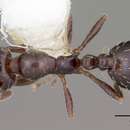en
names in breadcrumbs


Taxonomic history
Emery, 1895d PDF: 274 (m.); Wheeler & Wheeler, 1955c PDF: 122 (l.); Crozier, 1970a PDF: 116 (k.).Combination in Monomorium: Emery, 1895d PDF: 274.Subspecies of Monomorium minutum: Emery, 1895d PDF: 274; Wheeler, 1904f PDF: 301; Wheeler, 1906g PDF: 2.Revived status as species: Wheeler, 1910a PDF: 562; Wheeler, 1913d PDF: 115; Wheeler, 1914c PDF: 42; Dennis, 1938 PDF: 279.Senior synonym of Monomorium atra: Emery, 1895d PDF: 274.Senior synonym of Monomorium metoecus: Brown, 1966d PDF: 90.See also: Wheeler & Wheeler, 1973a PDF: 30; DuBois, 1986 PDF: 76.Kempf (1972) recorded this species from Paraguay, following Forel (1917). However, I know of no confirmed records of this species from Paraguay or any other Neotropical country and it is not included in the key below.
Literature records: Central (Forel 1907b).
Monomorium minimum is a North American species. Record may refer to the introduced species M. floricola .
The little black ant (Monomorium minimum) is a species of ant native to North America.[1] It is a shiny black color, the workers about 1 to 2 mm long and the queens 4 to 5 mm long. It is a monomorphic species, with only one caste of worker, and polygyne, meaning a nest may have more than one queen. A colony is usually moderately sized with only a few thousand workers.
Monomorium minimum are scavengers that will consume anything from bird droppings to dead insects. They are predators of codling moth larvae, and also of fall webworm.[2][3] Workers may forage in households, but nest in soil mounds. They harvest the honeydew of aphids such as the soybean aphid (Aphis glycines).[4]
During mid-summer the queens and males perform the nuptial flight, mating in midair. The males die shortly after. Each queen constructs a new nest, sheds its wings, and lays eggs. The development from egg to adult takes about a month.
In a laboratory setting queens were found to live about one year and workers about four months.
The little black ant (Monomorium minimum) is a species of ant native to North America. It is a shiny black color, the workers about 1 to 2 mm long and the queens 4 to 5 mm long. It is a monomorphic species, with only one caste of worker, and polygyne, meaning a nest may have more than one queen. A colony is usually moderately sized with only a few thousand workers.
Monomorium minimum are scavengers that will consume anything from bird droppings to dead insects. They are predators of codling moth larvae, and also of fall webworm. Workers may forage in households, but nest in soil mounds. They harvest the honeydew of aphids such as the soybean aphid (Aphis glycines).
During mid-summer the queens and males perform the nuptial flight, mating in midair. The males die shortly after. Each queen constructs a new nest, sheds its wings, and lays eggs. The development from egg to adult takes about a month.
In a laboratory setting queens were found to live about one year and workers about four months.
 Monomorium minimum ant foraging
Monomorium minimum ant foraging